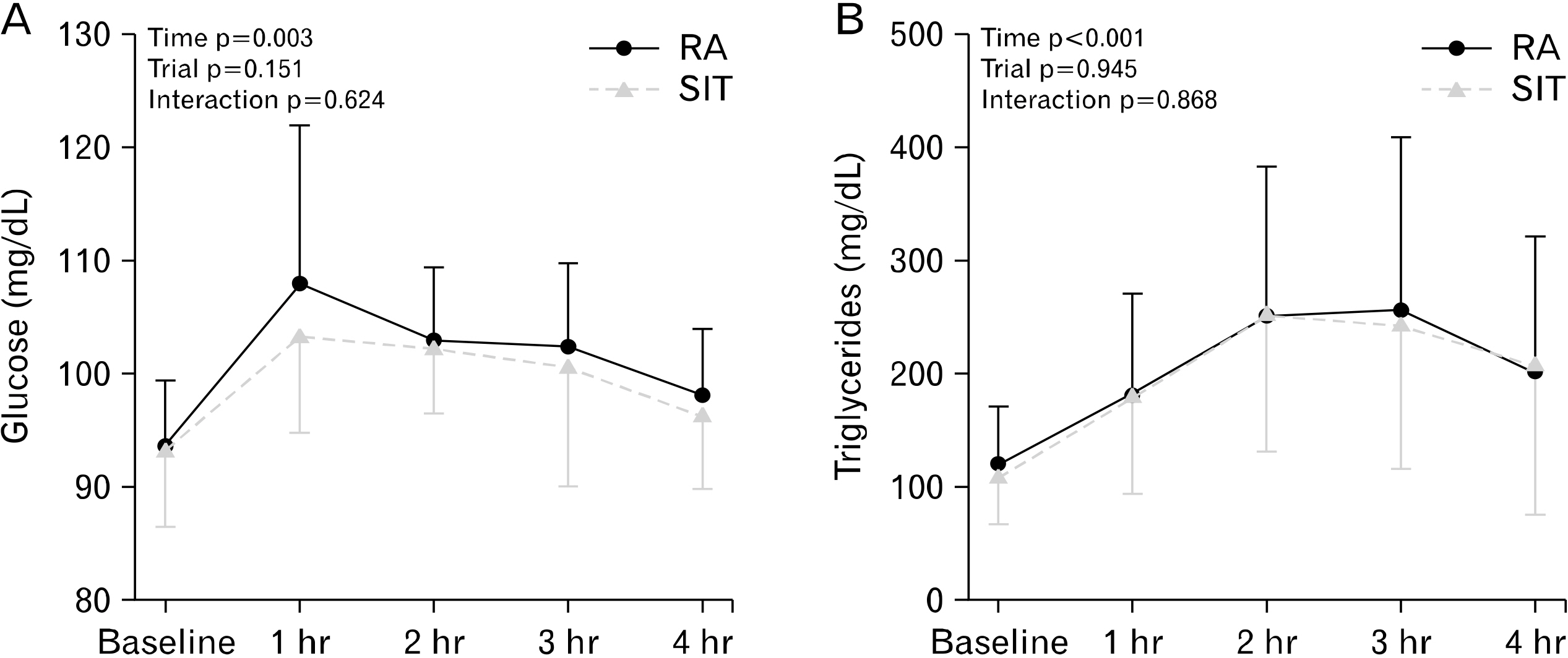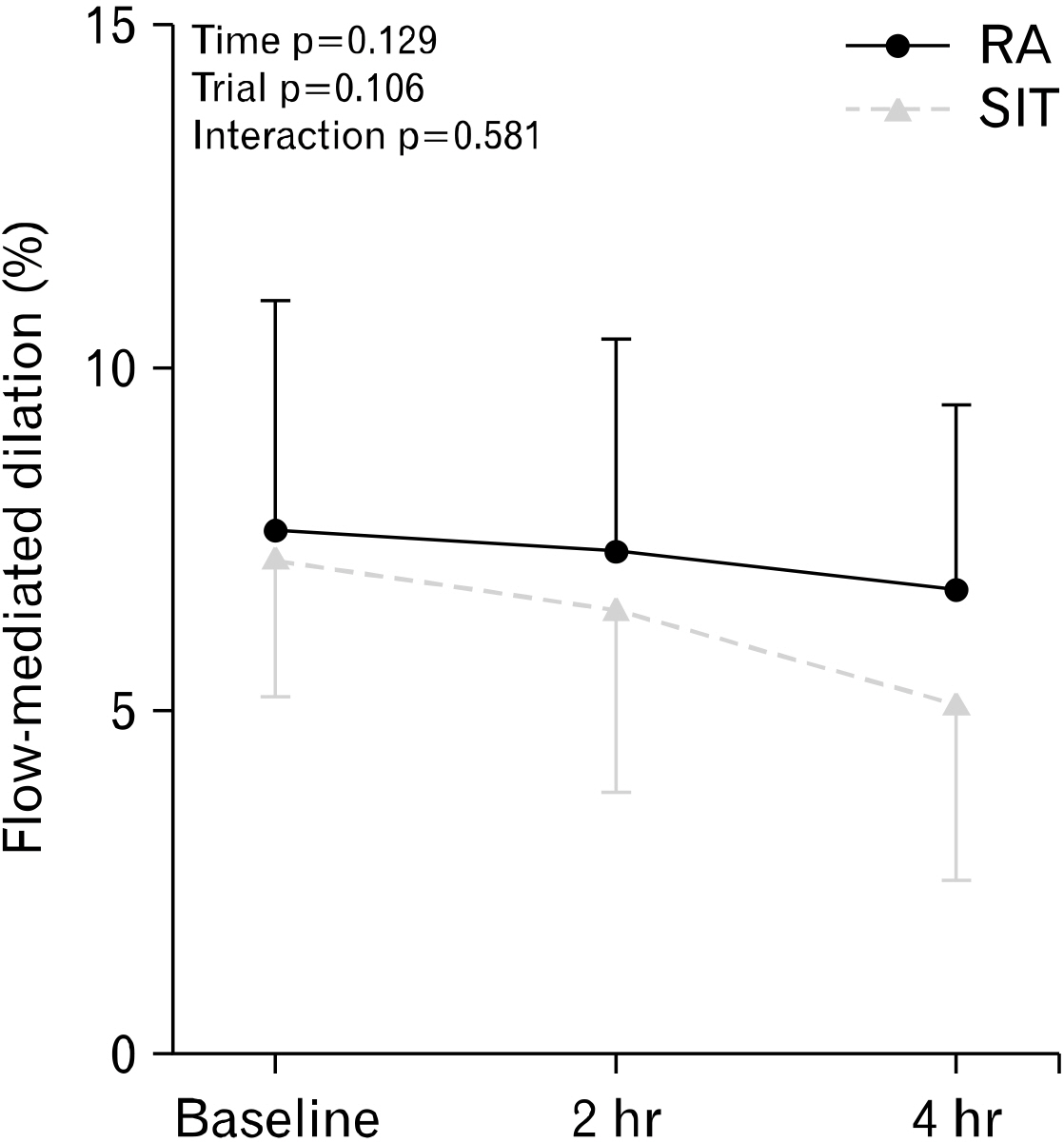Korean J Sports Med.
2023 Jun;41(2):90-99. 10.5763/kjsm.2023.41.2.90.
The Effect of Intermittent Resistance Activity for Interrupting Prolonged Sitting on Vascular Function and Postprandial Metabolism after a High-fat Meal
- Affiliations
-
- 1Department of Sport Science, University of Seoul, Seoul, Korea
- 2Division of Urban Social Health, Graduate School of Urban Public Health, University of Seoul, Seoul, Korea
- KMID: 2542980
- DOI: http://doi.org/10.5763/kjsm.2023.41.2.90
Abstract
- Purpose
Numerous studies have reported the effects of interrupting prolonged sitting with aerobic exercise on vascular and postprandial function, but the effects of resistance exercise for interrupting prolonged sitting remain unclear. We tested the hypothesis that intermittent resistance activity breaks would attenuate prolonged sittinginduced vascular and postprandial metabolic dysfunction.
Methods
Fourteen healthy adults (age, 24±2 years; body mass index, 22.0±2.4 kg/m2 ) completed two trials in a randomized cross-over design. During a 4-hour sitting after a high-fat meal, the participants underwent either resistance activity (RA) with 10 repetitions of five exercises every hour or uninterrupted sitting as a control trial (SIT). Plasma glucose, triglycerides, and brachial artery blood pressure, along with blood flow and shear rate in the superficial femoral artery and carotid artery were measured at baseline and every hour during the 4-hour sitting period. Brachial artery flow-mediated dilation (FMD) was measured at baseline, 2 hours, and 4 hours after the start of the sitting.
Results
Plasma glucose and triglycerides increased after a high-fat meal in both RA and SIT groups without a significant interaction effect. In addition, while SIT group decreased brachial artery FMD (7.2%±2.0% to 6.5%±2.7% to 5.1%±2.6%), RA did not attenuate a decrease in FMD (7.6%±3.4% to 7.3%±3.1% to 6.7%±2.7%, interaction p=0.581).
Conclusion
Our findings indicate that interrupting prolonged sitting with intermittent RA did not attenuate the negative effects of sitting on vascular function and postprandial metabolism in young healthy adults.
Keyword
Figure
Reference
-
1. Tremblay MS, Aubert S, Barnes JD, et al. 2017; Sedentary Behavior Research Network (SBRN): Terminology Consensus Project process and outcome. Int J Behav Nutr Phys Act. 14:75. DOI: 10.1186/s12966-017-0525-8. PMID: 28599680. PMCID: PMC5466781.2. Biswas A, Oh PI, Faulkner GE, et al. 2015; Sedentary time and its association with risk for disease incidence, mortality, and hospitalization in adults: a systematic review and meta-analysis. Ann Intern Med. 162:123–32. DOI: 10.7326/M14-1651. PMID: 25599350.
Article3. Ekelund U, Steene-Johannessen J, Brown WJ, et al. 2016; Does physical activity attenuate, or even eliminate, the detrimental association of sitting time with mortality?: a harmonised meta-analysis of data from more than 1 million men and women. Lancet. 388:1302–10. DOI: 10.1016/S0140-6736(16)30370-1. PMID: 27475271.
Article4. Inaba Y, Chen JA, Bergmann SR. 2010; Prediction of future cardiovascular outcomes by flow-mediated vasodilatation of brachial artery: a meta-analysis. Int J Cardiovasc Imaging. 26:631–40. DOI: 10.1007/s10554-010-9616-1. PMID: 20339920.
Article5. Pekas EJ, Allen MF, Park SY. 2023; Prolonged sitting and peripheral vascular function: potential mechanisms and methodological considerations. J Appl Physiol (1985). 134:810–22. DOI: 10.1152/japplphysiol.00730.2022. PMID: 36794688.
Article6. Latouche C, Jowett JB, Carey AL, et al. 2013; Effects of breaking up prolonged sitting on skeletal muscle gene expression. J Appl Physiol (1985). 114:453–60. DOI: 10.1152/japplphysiol.00978.2012. PMID: 23271697.
Article7. Nordestgaard BG, Benn M, Schnohr P, Tybjaerg-Hansen A. 2007; Nonfasting triglycerides and risk of myocardial infarction, ischemic heart disease, and death in men and women. JAMA. 298:299–308. DOI: 10.1001/jama.298.3.299. PMID: 17635890.8. Thosar SS, Bielko SL, Mather KJ, Johnston JD, Wallace JP. 2015; Effect of prolonged sitting and breaks in sitting time on endothelial function. Med Sci Sports Exerc. 47:843–9. DOI: 10.1249/MSS.0000000000000479. PMID: 25137367.
Article9. Cho MJ, Bunsawat K, Kim HJ, Yoon ES, Jae SY. 2020; The acute effects of interrupting prolonged sitting with stair climbing on vascular and metabolic function after a high-fat meal. Eur J Appl Physiol. 120:829–39. DOI: 10.1007/s00421-020-04321-9. PMID: 32065258.
Article10. Kowalsky RJ, Hergenroeder AL, Barone Gibbs B. 2021; Acceptability and impact of office-based resistance exercise breaks. Workplace Health Saf. 69:359–65. DOI: 10.1177/2165079920983820. PMID: 33509068.
Article11. Climie RE, Wheeler MJ, Grace M, et al. 2018; Simple intermittent resistance activity mitigates the detrimental effect of prolonged unbroken sitting on arterial function in overweight and obese adults. J Appl Physiol (1985). 125:1787–1794. DOI: 10.1152/japplphysiol.00544.2018. PMID: 30188800.12. Dempsey PC, Larsen RN, Sethi P, et al. 2016; Benefits for type 2 diabetes of interrupting prolonged sitting with brief bouts of light walking or simple resistance activities. Diabetes Care. 39:964–72. DOI: 10.2337/dc15-2336. PMID: 27208318.13. Howley ET. 2001; Type of activity: resistance, aerobic and leisure versus occupational physical activity. Med Sci Sports Exerc. 33(6 Suppl):S364–9. DOI: 10.1097/00005768-200106001-00005. PMID: 11427761.
Article14. Ashor AW, Lara J, Siervo M, et al. 2015; Exercise modalities and endothelial function: a systematic review and dose-response meta-analysis of randomized controlled trials. Sports Med. 45:279–96. DOI: 10.1007/s40279-014-0272-9. PMID: 25281334.
Article15. Padilla J, Harris RA, Fly AD, Rink LD, Wallace JP. 2006; The effect of acute exercise on endothelial function following a high-fat meal. Eur J Appl Physiol. 98:256–62. DOI: 10.1007/s00421-006-0272-z. PMID: 16896723.16. Liguori G. American College of Sports Medicine (ACSM). ACSM's guidelines for exercise testing and prescription. 11th ed, Paperback. LWW;2021.17. Thijssen DH, Bruno RM, van Mil AC, et al. 2019; Expert consensus and evidence-based recommendations for the assessment of flow-mediated dilation in humans. Eur Heart J. 40:2534–47. DOI: 10.1093/eurheartj/ehz350. PMID: 31211361.18. Thosar SS, Bielko SL, Wiggins CC, Wallace JP. 2014; Differences in brachial and femoral artery responses to prolonged sitting. Cardiovasc Ultrasound. 12:50. DOI: 10.1186/1476-7120-12-50. PMID: 25512175. PMCID: PMC4290438.19. Headid RJ 3rd, Pekas EJ, Wooden TK, et al. 2020; Impacts of prolonged sitting with mild hypercapnia on vascular and autonomic function in healthy recreationally active adults. Am J Physiol Heart Circ Physiol. 319:H468–80. DOI: 10.1152/ajpheart.00354.2020. PMID: 32648821. PMCID: PMC7473928.20. Grasser EK, Yepuri G, Dulloo AG, Montani JP. 2014; Cardio- and cerebrovascular responses to the energy drink Red Bull in young adults: a randomized cross-over study. Eur J Nutr. 53:1561–71. DOI: 10.1007/s00394-014-0661-8. PMID: 24474552. PMCID: PMC4175045.21. Wolters FJ, Zonneveld HI, Hofman A, et al. 2017; Cerebral perfusion and the risk of dementia: a population-based study. Circulation. 136:719–28. DOI: 10.1161/CIRCULATIONAHA.117.027448. PMID: 28588075.22. Fewkes JJ, Kellow NJ, Cowan SF, Williamson G, Dordevic AL. 2022; A single, high-fat meal adversely affects postprandial endothelial function: a systematic review and meta-analysis. Am J Clin Nutr. 116:699–729. DOI: 10.1093/ajcn/nqac153. PMID: 35665799. PMCID: PMC9437993.
Article23. Carter SE, Draijer R, Holder SM, Brown L, Thijssen DH, Hopkins ND. 2019; Effect of different walking break strategies on superficial femoral artery endothelial function. Physiol Rep. 7:e14190. DOI: 10.14814/phy2.14190. PMID: 31423757. PMCID: PMC6698486.
Article24. Taylor FC, Pinto AJ, Maniar N, Dunstan DW, Green DJ. 2022; The acute effects of prolonged uninterrupted sitting on vascular function: a systematic review and meta-analysis. Med Sci Sports Exerc. 54:67–76. DOI: 10.1249/MSS.0000000000002763. PMID: 34334722.
Article25. Heffernan KS, Collier SR, Kelly EE, Jae SY, Fernhall B. 2007; Arterial stiffness and baroreflex sensitivity following bouts of aerobic and resistance exercise. Int J Sports Med. 28:197–203. DOI: 10.1055/s-2006-924290. PMID: 17024636.
Article26. Carter SE, Gladwell VF. 2017; Effect of breaking up sedentary time with callisthenics on endothelial function. J Sports Sci. 35:1508–14. DOI: 10.1080/02640414.2016.1223331. PMID: 27559678.
Article27. Benatti FB, Ried-Larsen M. 2015; The effects of breaking up prolonged sitting time: a review of experimental studies. Med Sci Sports Exerc. 47:2053–61. DOI: 10.1249/MSS.0000000000000654. PMID: 26378942.28. Gill JM, Herd SL, Vora V, Hardman AE. 2003; Effects of a brisk walk on lipoprotein lipase activity and plasma triglyceride con-centrations in the fasted and postprandial states. Eur J Appl Physiol. 89:408. DOI: 10.1007/s00421-003-0827-1. PMID: 27520836.
Article29. Stöllberger C, Finsterer J. 2019; Side effects of whole-body electro-myo-stimulation. Wien Med Wochenschr. 169:173–80. DOI: 10.1007/s10354-018-0655-x.
Article30. Santos JM, Ribeiro SB, Gaya AR, Appell HJ, Duarte JA. 2008; Skeletal muscle pathways of contraction-enhanced glucose uptake. Int J Sports Med. 29:785–94. DOI: 10.1055/s-2008-1038404. PMID: 18401805.
Article
- Full Text Links
- Actions
-
Cited
- CITED
-
- Close
- Share
- Similar articles
-
- Effect of an Exergaming on Postprandial Endothelial Dysfunction Following a High Fat Meal in Individuals with Spinal Cord Injury
- Postprandial Hypertriglyceridemia Following a Single High-Fat Meal in Patients with Coronary Artery Disease and Normal Subjects: The Significance of the Postprandial Hypertriglyceridemia and the Effects of Fibrate on the Postprandial Hypertriglyceridemia
- Intermittent Fasting: a Promising Approach for Preventing Vascular Dementia
- The Effect of Vitamin E on the Endothelial Function Following a Single High-Fat Meal in Normal Subjects, Patients with Coronary Heart Disease and Patients with Diabetes
- The Effect Of a Meal on Cardiac Function in Healthy Young Men Evaluated by Echocardiography




